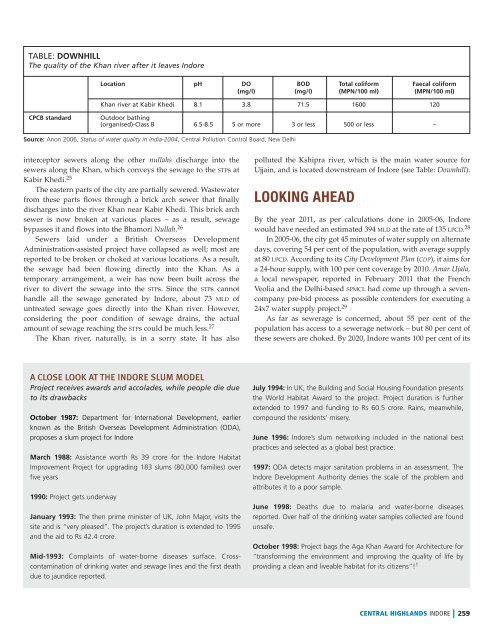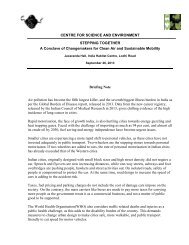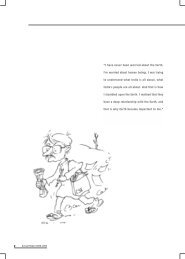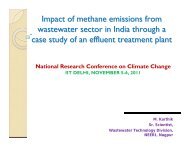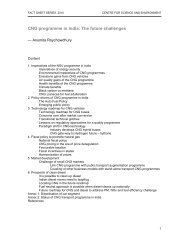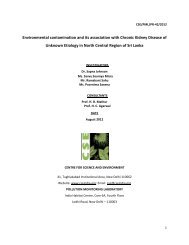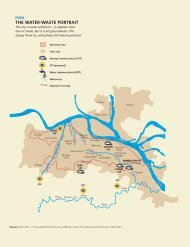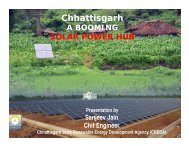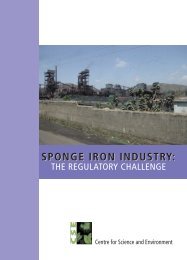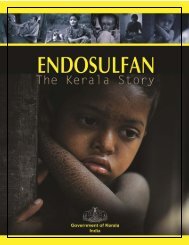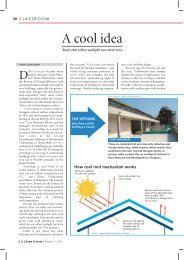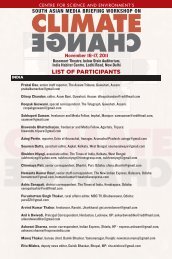Indore The Water-Waste Portrait - Centre for Science and Environment
Indore The Water-Waste Portrait - Centre for Science and Environment
Indore The Water-Waste Portrait - Centre for Science and Environment
Create successful ePaper yourself
Turn your PDF publications into a flip-book with our unique Google optimized e-Paper software.
TABLE: DOWNHILL<br />
<strong>The</strong> quality of the Khan river after it leaves <strong>Indore</strong><br />
Location pH DO BOD Total coli<strong>for</strong>m Faecal coli<strong>for</strong>m<br />
(mg/l) (mg/l) (MPN/100 ml) (MPN/100 ml)<br />
Khan river at Kabir Khedi 8.1 3.8 71.5 1600 120<br />
CPCB st<strong>and</strong>ard Outdoor bathing<br />
(organised)-Class B 6.5-8.5 5 or more 3 or less 500 or less –<br />
Source: Anon 2006, Status of water quality in India-2004, Central Pollution Control Board, New Delhi<br />
interceptor sewers along the other nullahs discharge into the<br />
sewers along the Khan, which conveys the sewage to the STPs at<br />
Kabir Khedi. 25<br />
<strong>The</strong> eastern parts of the city are partially sewered. <strong>Waste</strong>water<br />
from these parts flows through a brick arch sewer that finally<br />
discharges into the river Khan near Kabir Khedi. This brick arch<br />
sewer is now broken at various places – as a result, sewage<br />
bypasses it <strong>and</strong> flows into the Bhamori Nullah. 26<br />
Sewers laid under a British Overseas Development<br />
Administration-assisted project have collapsed as well; most are<br />
reported to be broken or choked at various locations. As a result,<br />
the sewage had been flowing directly into the Khan. As a<br />
temporary arrangement, a weir has now been built across the<br />
river to divert the sewage into the STPs. Since the STPs cannot<br />
h<strong>and</strong>le all the sewage generated by <strong>Indore</strong>, about 73 MLD of<br />
untreated sewage goes directly into the Khan river. However,<br />
considering the poor condition of sewage drains, the actual<br />
amount of sewage reaching the STPs could be much less. 27<br />
<strong>The</strong> Khan river, naturally, is in a sorry state. It has also<br />
A CLOSE LOOK AT THE INDORE SLUM MODEL<br />
Project receives awards <strong>and</strong> accolades, while people die due<br />
to its drawbacks<br />
October 1987: Department <strong>for</strong> International Development, earlier<br />
known as the British Overseas Development Administration (ODA),<br />
proposes a slum project <strong>for</strong> <strong>Indore</strong><br />
March 1988: Assistance worth Rs 39 crore <strong>for</strong> the <strong>Indore</strong> Habitat<br />
Improvement Project <strong>for</strong> upgrading 183 slums (80,000 families) over<br />
five years<br />
1990: Project gets underway<br />
January 1993: <strong>The</strong> then prime minister of UK, John Major, visits the<br />
site <strong>and</strong> is “very pleased”. <strong>The</strong> project’s duration is extended to 1995<br />
<strong>and</strong> the aid to Rs 42.4 crore.<br />
Mid-1993: Complaints of water-borne diseases surface. Crosscontamination<br />
of drinking water <strong>and</strong> sewage lines <strong>and</strong> the first death<br />
due to jaundice reported.<br />
polluted the Kshipra river, which is the main water source <strong>for</strong><br />
Ujjain, <strong>and</strong> is located downstream of <strong>Indore</strong> (see Table: Downhill).<br />
LOOKING AHEAD<br />
By the year 2011, as per calculations done in 2005-06, <strong>Indore</strong><br />
would have needed an estimated 394 MLD at the rate of 135 LPCD. 28<br />
In 2005-06, the city got 45 minutes of water supply on alternate<br />
days, covering 54 per cent of the population, with average supply<br />
at 80 LPCD. According to its City Development Plan (CDP), it aims <strong>for</strong><br />
a 24-hour supply, with 100 per cent coverage by 2010. Amar Ujala,<br />
a local newspaper, reported in February 2011 that the French<br />
Veolia <strong>and</strong> the Delhi-based SPMCL had come up through a sevencompany<br />
pre-bid process as possible contenders <strong>for</strong> executing a<br />
24x7 water supply project. 29<br />
As far as sewerage is concerned, about 55 per cent of the<br />
population has access to a sewerage network – but 80 per cent of<br />
these sewers are choked. By 2020, <strong>Indore</strong> wants 100 per cent of its<br />
July 1994: In UK, the Building <strong>and</strong> Social Housing Foundation presents<br />
the World Habitat Award to the project. Project duration is further<br />
extended to 1997 <strong>and</strong> funding to Rs 60.5 crore. Rains, meanwhile,<br />
compound the residents’ misery.<br />
June 1996: <strong>Indore</strong>’s slum networking included in the national best<br />
practices <strong>and</strong> selected as a global best practice.<br />
1997: ODA detects major sanitation problems in an assessment. <strong>The</strong><br />
<strong>Indore</strong> Development Authority denies the scale of the problem <strong>and</strong><br />
attributes it to a poor sample.<br />
June 1998: Deaths due to malaria <strong>and</strong> water-borne diseases<br />
reported. Over half of the drinking water samples collected are found<br />
unsafe.<br />
October 1998: Project bags the Aga Khan Award <strong>for</strong> Architecture <strong>for</strong><br />
“trans<strong>for</strong>ming the environment <strong>and</strong> improving the quality of life by<br />
providing a clean <strong>and</strong> liveable habitat <strong>for</strong> its citizens”! 1<br />
CENTRAL HIGHLANDS INDORE | 259


